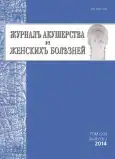The role of complex preoperative urodynamic testing of continent women when planning surgery for pelvic organ prolapse
- Authors: Rusina Y.I.1
-
Affiliations:
- D. O. Ott Research Institute of Obstetrics and Gynecology, RAMS
- Issue: Vol 63, No 1 (2014)
- Pages: 17-25
- Section: Articles
- URL: https://journals.rcsi.science/jowd/article/view/2705
- DOI: https://doi.org/10.17816/JOWD63117-25
- ID: 2705
Cite item
Full Text
Abstract
Full Text
##article.viewOnOriginalSite##About the authors
Yelena Ivanovna Rusina
D. O. Ott Research Institute of Obstetrics and Gynecology, RAMS
Email: pismo_rusina@mail.ru
assistant professor of Operative Gynecology Department
References
- Кулаков В. И., Манухин И. Б., Савельева Г. М. Национальное руководство. Гинекология. М.: ГЭОТАР-Медиа; 2007.
- Пушкарь Д. Ю., Гумин Л. М. Уродинамическое исследование у женщины. М.: МЕД пресс-информ; 2006.
- Савицкий Г. А., Савицкий А. Г., Беженарь В. Ф. Уродинамические аспекты недержания мочи при напряжении у женщин. СПб.: Синтез Бук; 2008.
- Чечнева М. А. Рациональная концепция комплексного обследования женщин с синдромом тазовой дисфункции и мочевой инконтиненции. Автореф. дис… д-ра мед. наук. М.; 2011
- Ballert K. N., Biggs G. Y., Isenalumhe A. Jr., Rosenblum N., Nitti V. W. Managing the urethra at transvaginal pelvic organ prolapse repair: a urodynamic approach. J. Urol. 2009; 181: 679-84.
- Cho S. T., Song H. C., Song H. J. et al. Predictors of postoperative voiding dysfunction following transobsturator sling procedures in patients with stress urinary incontinence. Int. Neurourol. J. 2010; 14: 26-33.
- de Boer T. A., Slieker-ten Hove M. C., Burger C. W., Vierhout M. E. The prevalence and risk factors of overactive bladder symptoms and its relation to pelvic organ prolapse symptoms in a general female population. Int. Urogynecol. J. 2011; 22 (5): 569-75.
- Elser D. M., Moen M. D., Stanford E. J. et al. Abdominal sacrocolpopexy and urinary incontinence: surgical planning based on urodynamics. Am. J. Obstet. Gynecol. 2010; 202: 375.
- Guldberg R., Kesmodel U. S., Hansen J. K. et al. Patient reported outcome measures in women undergoing surgery for urinary incontinence and pelvic organ prolapse in Denmark 2006-2011. Int Urogynecol. J. 2013; 24 (7): 1127-34.
- Jha S., Toozs-Hobson P., Parsons M., Gull F. Does preoperative urodynamics change the management of prolapse? J. Obstet. Gynaecol. 2008; 28 (3): 320-2.
- Kirby A. C., Nager C. W., Litman H. J. et al. Preoperative voiding detrusor pressures do not predict stress incontinence surgery outcomes. Int.Urogynecol. J. 2011; 22: 657-63.
- Lee D. M., Ryu Y. W., Lee Y. T. et al. A predictive factor in overactive bladder symptoms improvement after combined anterior vaginal wall prolapse repair: a pilot study. Korean J. Urol. 2012; 53 (6): 405-9.
- Lemack G. E., Krauss S., Litman H. et al. Normal preoperative urodynamic testing does not predict voiding dysfunction after Burch colposuspension versus pubovaginal sling. J. Urol. 2008; 180: 2076-80.
- Lensen E. J. M., Withagen M. I., Kluivers K. B. et al. Urinary incontinence after surgery for pelvic organ prolapse. Neurourol. Urodynam. 2013; 32 (5): 455-9.
- Liang C. C., Chang Y. L., Chang S. D. et al. Pessary test to predict postoperative urinary incontinence in women undergoing hysterectomy for prolapse. Obstet. Gynecol. 2004; 104 (4): 795-800.
- Miller E. A., Amundsen C. L., Toh K. L. et al. Preoperative urodynamic evaluation may predict voiding dysfunction in women undergoing pubovaginal sling. J. Urol. 2003; 169: 2234.
- Mueller E. R., Kenton K., Mahajan S. et al. Urodynamic prolapse reduction alters urethral pressure but not filling or pressure flow parameters. J. Urol. 2007; 177: 600-3.
- Nager C. W., Kraus S. R., Kenton K. et al. Urodynamics, the supine empty bladder stress test, and incontinence severity. Neurourol. Urodyn. 2010; 29 (7): 1306-11.
- Visco A. G., Brubaker L., Nygaard I. et al. The role of preoperative urodynamic testing in stress-continent women undergoing sacrocolpopexy: the Colpopexy and Urinary Reduction Efforts (CARE) randomized surgical trial. Int. Urogynecol. J. Pelvic Floor Dysfunct. 2008; 19: 607-14.
- Wei J. T., Nygaard I., Richter H. E. et al. A midurethral sling to reduce incontinence after vaginal prolapse repair N. Engl. J. Med. 2012; 366 (25): 2358-67.
Supplementary files







